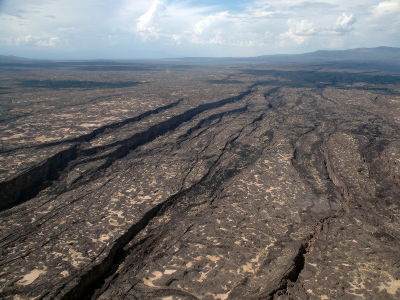The tsunami produced by the asteroid impact that wiped out the dinosaurs reached 1.5 km in height and reached almost all coastlines in 48 hours.

About 66 million years ago, an asteroid with a diameter of about 14 km collided near the Yucatan Peninsula in Mexico, and it is said that about three-fourths of all animal and plant species, including dinosaurs, became extinct. A simulation model was used to analyze the tsunami generated by this asteroid impact, and geological data recorded at more than 100 sites around the world was analyzed . It turned out to be powerful.
The Chicxulub Impact Produced a Powerful Global Tsunami - Range - 2022 - AGU Advances - Wiley Online Library
https://doi.org/10.1029/2021AV000627
Dinosaur-killing asteroid triggered global tsunami that scoured seafloor thousands of miles from impact site | University of Michigan News
https://news.umich.edu/dinosaur-killing-asteroid-triggered-global-tsunami-that-scoured-seafloor-thousands-of-miles-from-impact-site/
Tsunami from dinosaur-killing asteroid had mile-high waves and reached halfway across the world | Live Science
https://www.livescience.com/dinosaur-killing-asteroid-triggered-giant-tsunami
Asteroid that wiped out the dinosaurs also triggered a global tsunami | CNN
https://edition.cnn.com/2022/10/04/world/dinosaur-asteroid-tsunami-scn/index.html
An asteroid impact about 66 million years ago caused massive earthquakes and volcanic eruptions, incredibly large tsunamis, rapid temperature rises and cooling due to the lack of sunlight. This mass extinction is also called the K-Pg boundary , and even at the time of writing the article, traces of asteroid collisions remain on the earth.
What is the ``trace of the giant meteorite that caused the mass extinction of the dinosaurs'' that remains on the earth? -GIGAZINE

A team led by researchers from the University of Michigan has published findings about the tsunami generated by this asteroid impact. First, the research team modeled the events that occurred in the first 10 minutes of the asteroid impact using a computer model that analyzes large-scale collisions called Hydrocode.
Based on existing research, this model analysis assumed that an asteroid with a diameter of 14 km collided with the earth at a speed of 43,200 km per hour. The asteroid collided with the granite crust covered with thick sediment and shallow seawater, forming a crater with a width of about 100 km and releasing soot and dust into the atmosphere. Subsequently, water was pushed out by the object ejected from the collision point, temporarily generating a wave of 4.5 km in height, and 10 minutes after the collision, a tsunami of 1.5 km in height was generated at a point 220 km away from the collision point. It is said that it was formed and began to spread in all directions across the sea.

Next, the research team input the results of this hydrocode simulation into two global ocean models,

Four hours later, the tsunami reached the Pacific Ocean through the Central American Seaway, which separated the North and South Americas at that time, as shown in the image below. According to the simulation model, the height of the tsunami in the open ocean of the Gulf of Mexico exceeded 100 m, and the tsunami that reached the North Atlantic coast and the Pacific coast of South America exceeded 10 m.

Twenty-four hours later, the tsunami crossed the Pacific and Atlantic Oceans, entering the Indian Ocean from both directions.

After 48 hours, the tsunami reached almost all coastlines. The tsunami energy is estimated to be about 30,000 times greater than the 2004

The ocean current velocity due to this tsunami exceeded 20 cm per second, which is sufficient to erode seabed sediments in the North Atlantic and South Pacific, and about half of the ocean basins on the earth were affected. On the other hand, it is highly likely that current velocities did not exceed 20 cm/s in the South Atlantic, North Pacific, Indian Ocean, and Mediterranean Sea, and it is believed that the sediment in the ocean basin was not affected by the tsunami.
In addition to computer models, the research team also analyzed sedimentary geological data collected at 120 locations around the world. These data are mostly geological cores collected by scientific ocean drilling projects, and the research team examined sediment conditions at the K-Pg boundary , which marks a mass extinction about 66 million years ago.
As a result, there are few cores with complete and uninterrupted K-Pg boundary sediments in the North Atlantic and South Pacific, and the sites in the South Atlantic, North Pacific, Indian Ocean and Mediterranean have uninterrupted K-Pg boundaries. It is said that there were many things left. About this discovery, Professor Brian Arbic of the University of Michigan Department of Earth and Environmental Sciences said, 'We have found geological evidence for the areas that are expected to be most affected in the open ocean.'
Theodore Moore, co-author of the paper and professor emeritus at the University of Michigan, said, 'The big breakthrough in this study is that the two different formulations of the global ocean model yielded nearly identical results, and the geological data matched those results. The model and the validation data matched perfectly,' commented. 'This tsunami was strong enough to disturb and erode sediments in ocean basins halfway around the globe,' said lead author Maury Range of the University of Michigan.
Related Posts:
in Science, Posted by log1h_ik







